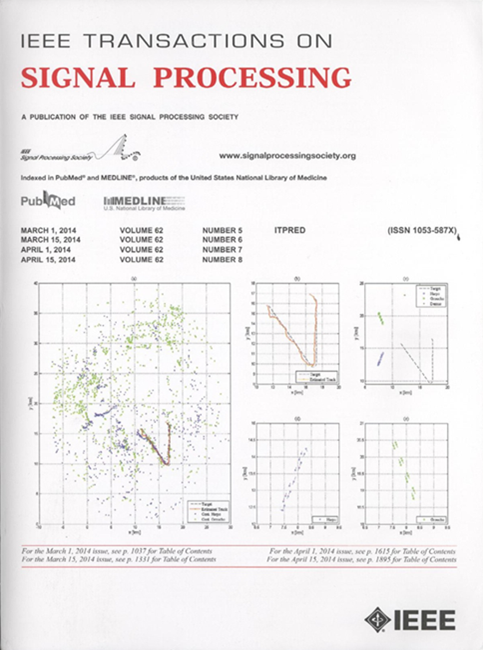使用数据类直角坐标或准直角坐标信号的通信网络广泛线性 MMSE 接收器的新见解
IF 5.8
2区 工程技术
Q1 ENGINEERING, ELECTRICAL & ELECTRONIC
引用次数: 0
摘要
在过去的二十年里,宽线性(WL)处理技术一直是无线电通信网络多用户(MUI)干扰缓解的重要研究课题,尤其是在使用直线性(R)或准直线性(QR)信号的无线电通信网络中。尽管有关这一主题的论文不胜枚举,但这一主题对于当前和未来使用 R 或 QR 信号的几种应用仍具有重要意义,下文将对此进行介绍。在此背景下,本文采用连续时间方法,展示了文献中大多数 WL MMSE 接收机的次优性,这些接收机是在对脉冲整形滤波器进行匹配滤波操作后,在符号率上实现的,而且必须知道 MUI 信道(在实践中总是很麻烦),才能实现最佳 WL MMSE 接收机。因此,本文要解决的主要难题是提出新的 WL MMSE 接收机,无需 MUI 信道知识即可实现最佳接收机。为此,本文针对被数据类 MUI 破坏的 R 和 QR 信号,提出并分析了两种新的 WL MMSE 接收机,一种是双输入接收机,另一种是三输入接收机。结果表明,对于使用低滚降平方根余弦(SRRC)滤波器的 R 信号,以及使用任何脉冲整形滤波器的 R 和 QR 信号,两输入接收器和三输入接收器分别是准最优的,这尤其表明了 R 和 QR 信号对于 WL MMSE 接收器的非等效性。这两种新型接收器为在仅了解 SOI 信道的情况下,在存在类数据 MUI 的情况下实现最佳 WL MMSE 接收器开辟了新的前景。本文章由计算机程序翻译,如有差异,请以英文原文为准。
New Insights Into Widely Linear MMSE Receivers for Communication Networks Using Data-Like Rectilinear or Quasi-Rectilinear Signals
Widely linear (WL) processing has been of great interest these last two decades for multi-user (MUI) interference mitigation in radiocommunications networks using rectilinear (R) or quasi-rectilinear (QR) signals in particular. Despite numerous papers on the subject, this topic remains of interest for several current and future applications which use R or QR signals, described hereafter. In this context, using a continuous time approach, it is shown in this paper the sub-optimality of most of the WL MMSE receivers of the literature, which are implemented at the symbol rate after a matched filtering operation to the pulse shaping filter, and the necessity to know the MUI channels, always cumbersome in practice, to implement the optimal WL MMSE receiver. Then, the main challenge addressed in the paper is to propose new WL MMSE receivers able to implement the optimal one without requiring the MUI channels knowledge. For this purpose, two new WL MMSE receivers, a two-input one and a three-input one, are proposed and analyzed in this paper for R and QR signals corrupted by data-like MUI. The two-input and three-input receivers are shown to be quasi-optimal respectively for R signals using Square Root Raised Cosine (SRRC) filters with a low roll-off and for R and QR signals whatever the pulse shaping filter, showing in particular the non-equivalence of R and QR signals for WL MMSE receivers. These two new receivers open new perspectives for the implementation of the optimal WL MMSE receiver in the presence of data-like MUI from the only knowledge of the SOI channel.
求助全文
通过发布文献求助,成功后即可免费获取论文全文。
去求助
来源期刊

IEEE Transactions on Signal Processing
工程技术-工程:电子与电气
CiteScore
11.20
自引率
9.30%
发文量
310
审稿时长
3.0 months
期刊介绍:
The IEEE Transactions on Signal Processing covers novel theory, algorithms, performance analyses and applications of techniques for the processing, understanding, learning, retrieval, mining, and extraction of information from signals. The term “signal” includes, among others, audio, video, speech, image, communication, geophysical, sonar, radar, medical and musical signals. Examples of topics of interest include, but are not limited to, information processing and the theory and application of filtering, coding, transmitting, estimating, detecting, analyzing, recognizing, synthesizing, recording, and reproducing signals.
 求助内容:
求助内容: 应助结果提醒方式:
应助结果提醒方式:


